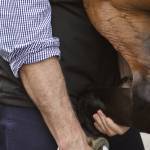Flexion Test is a Tool, Not a Guarantee

Lameness and pre-purchase exams commonly include a flexion test of the forelegs. The examining veterinarian flexes a horse’s leg, releases it, and asks that the horse immediately be trotted in a straight line. If subtle lameness is present, it can often be noted as the horse moves. In a note from The Horse, Dr. Rene van Weeren of Utrecht University pointed out that, in instances when foreleg lameness is detected by this test, it most often originates in or around the fetlock joint. The test indicates little or nothing about pain in the hoof or pastern.
In a test using 250 Newtons (54 pounds) of force to flex the legs of eight Dutch Warmblood horses, van Weeren found that every tested horse showed a positive result (an indication of lameness or pain). Because there are no guidelines for the amount of force or exact procedure to be used in performing flexion tests and the results have been shown to be influenced by a horse’s age and workload, van Weeren suggested that a flexion test be considered as only one factor in an exam.








